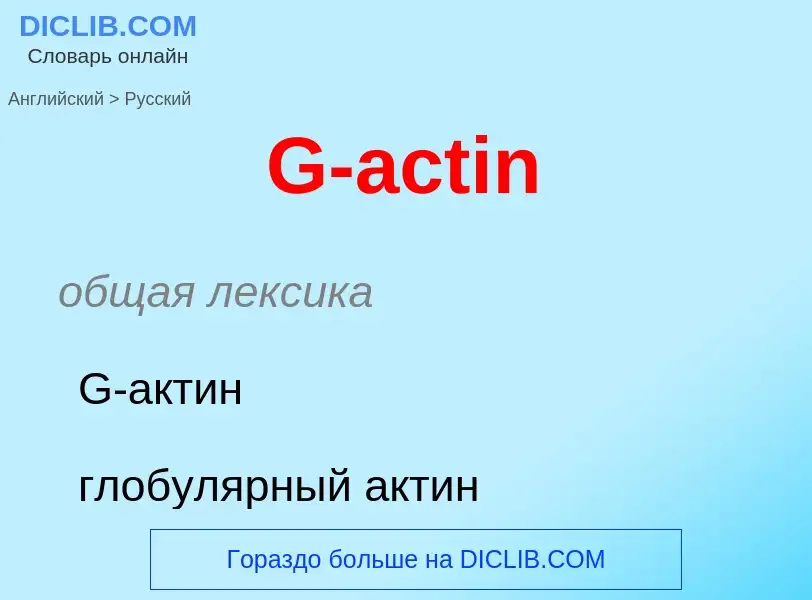Traduzione e analisi delle parole tramite l'intelligenza artificiale ChatGPT
In questa pagina puoi ottenere un'analisi dettagliata di una parola o frase, prodotta utilizzando la migliore tecnologia di intelligenza artificiale fino ad oggi:
- come viene usata la parola
- frequenza di utilizzo
- è usato più spesso nel discorso orale o scritto
- opzioni di traduzione delle parole
- esempi di utilizzo (varie frasi con traduzione)
- etimologia
G-actin - traduzione in Inglese
общая лексика
G-актин
глобулярный актин
Definizione
Wikipedia

Actin is a family of globular multi-functional proteins that form microfilaments in the cytoskeleton, and the thin filaments in muscle fibrils. It is found in essentially all eukaryotic cells, where it may be present at a concentration of over 100 μM; its mass is roughly 42 kDa, with a diameter of 4 to 7 nm.
An actin protein is the monomeric subunit of two types of filaments in cells: microfilaments, one of the three major components of the cytoskeleton, and thin filaments, part of the contractile apparatus in muscle cells. It can be present as either a free monomer called G-actin (globular) or as part of a linear polymer microfilament called F-actin (filamentous), both of which are essential for such important cellular functions as the mobility and contraction of cells during cell division.
Actin participates in many important cellular processes, including muscle contraction, cell motility, cell division and cytokinesis, vesicle and organelle movement, cell signaling, and the establishment and maintenance of cell junctions and cell shape. Many of these processes are mediated by extensive and intimate interactions of actin with cellular membranes. In vertebrates, three main groups of actin isoforms, alpha, beta, and gamma have been identified. The alpha actins, found in muscle tissues, are a major constituent of the contractile apparatus. The beta and gamma actins coexist in most cell types as components of the cytoskeleton, and as mediators of internal cell motility. It is believed that the diverse range of structures formed by actin enabling it to fulfill such a large range of functions is regulated through the binding of tropomyosin along the filaments.
A cell's ability to dynamically form microfilaments provides the scaffolding that allows it to rapidly remodel itself in response to its environment or to the organism's internal signals, for example, to increase cell membrane absorption or increase cell adhesion in order to form cell tissue. Other enzymes or organelles such as cilia can be anchored to this scaffolding in order to control the deformation of the external cell membrane, which allows endocytosis and cytokinesis. It can also produce movement either by itself or with the help of molecular motors. Actin therefore contributes to processes such as the intracellular transport of vesicles and organelles as well as muscular contraction and cellular migration. It therefore plays an important role in embryogenesis, the healing of wounds, and the invasivity of cancer cells. The evolutionary origin of actin can be traced to prokaryotic cells, which have equivalent proteins. Actin homologs from prokaryotes and archaea polymerize into different helical or linear filaments consisting of one or multiple strands. However the in-strand contacts and nucleotide binding sites are preserved in prokaryotes and in archaea. Lastly, actin plays an important role in the control of gene expression.
A large number of illnesses and diseases are caused by mutations in alleles of the genes that regulate the production of actin or of its associated proteins. The production of actin is also key to the process of infection by some pathogenic microorganisms. Mutations in the different genes that regulate actin production in humans can cause muscular diseases, variations in the size and function of the heart as well as deafness. The make-up of the cytoskeleton is also related to the pathogenicity of intracellular bacteria and viruses, particularly in the processes related to evading the actions of the immune system.


![[[Ribbon diagram]] of an actin monomer from rabbit skeletal muscle, with the molecule's surface shown semi-transparent. The four subdomains as well as the bound ATP and calcium ion are annotated. [[Ribbon diagram]] of an actin monomer from rabbit skeletal muscle, with the molecule's surface shown semi-transparent. The four subdomains as well as the bound ATP and calcium ion are annotated.](https://commons.wikimedia.org/wiki/Special:FilePath/1ATN image annotated.png?width=200)


![chaperonin]] CCT chaperonin]] CCT](https://commons.wikimedia.org/wiki/Special:FilePath/CCT gamma apical.png?width=200)

![The protein [[gelsolin]], which is a key regulator in the assembly and disassembly of actin. The protein [[gelsolin]], which is a key regulator in the assembly and disassembly of actin.](https://commons.wikimedia.org/wiki/Special:FilePath/Gelsolin.png?width=200)
![Albert von Szent-Györgyi Nagyrápolt]], co-discoverer of actin with [[Brunó Ferenc Straub]] Albert von Szent-Györgyi Nagyrápolt]], co-discoverer of actin with [[Brunó Ferenc Straub]]](https://commons.wikimedia.org/wiki/Special:FilePath/GyorgyiNIH.jpg?width=200)
![Fluorescence]] micrograph showing F-actin (in green) in rat [[fibroblast]]s Fluorescence]] micrograph showing F-actin (in green) in rat [[fibroblast]]s](https://commons.wikimedia.org/wiki/Special:FilePath/MEF microfilaments.jpg?width=200)
![Structure of [[MreB]], a bacterial protein whose three-dimensional structure resembles that of G-actin Structure of [[MreB]], a bacterial protein whose three-dimensional structure resembles that of G-actin](https://commons.wikimedia.org/wiki/Special:FilePath/MreB.png?width=200)

![nemaline rods]] produced by the [[transfection]] of a [[DNA sequence]] of ''[[ACTA1]]'', which is the carrier of a [[mutation]] responsible for nemaline myopathy<ref name="Bathe_2007"/> nemaline rods]] produced by the [[transfection]] of a [[DNA sequence]] of ''[[ACTA1]]'', which is the carrier of a [[mutation]] responsible for nemaline myopathy<ref name="Bathe_2007"/>](https://commons.wikimedia.org/wiki/Special:FilePath/Nemaline rods.jpg?width=200)

![eukariotic]] prefoldin has a similar structure.<ref name="Simons_2004"/> eukariotic]] prefoldin has a similar structure.<ref name="Simons_2004"/>](https://commons.wikimedia.org/wiki/Special:FilePath/Prefoldin.png?width=200)
![s2cid = 4359724 }}</ref> The profilin shown belongs to group II, normally present in the [[kidney]]s and the [[brain]]. s2cid = 4359724 }}</ref> The profilin shown belongs to group II, normally present in the [[kidney]]s and the [[brain]].](https://commons.wikimedia.org/wiki/Special:FilePath/Profilin actin complex.png?width=200)


